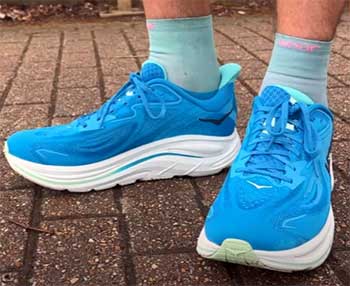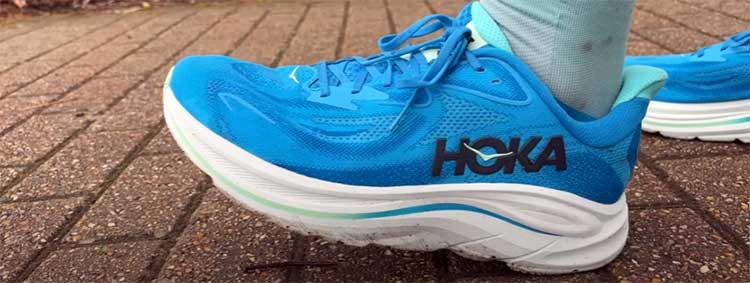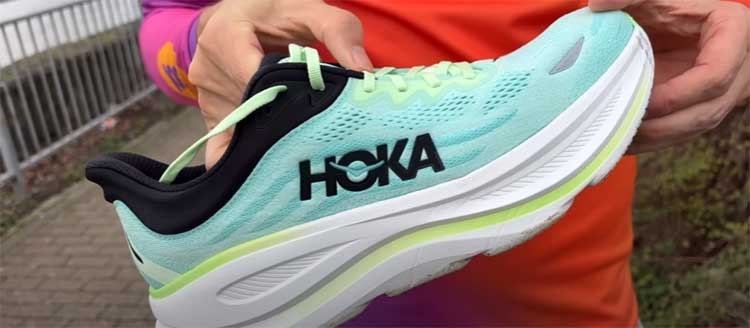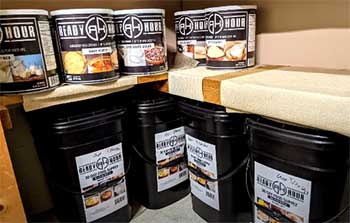I’ve been lacing up running shoes for years, pounding pavement and trails, chasing that perfect stride. When it came to choosing between Hoka’s Clifton and Bondi, I faced a dilemma many runners encounter: which shoe fits my needs?
In this article, I’ll share my experience testing both, breaking down their pros and cons to help you decide. From cushioning to fit, weight to durability, I’ll cover it all in a conversational yet analytical way, ensuring you have the insights to pick the right Hoka for your runs, walks, or long days on your feet.
A Brief Comparison Table
| Feature | Hoka Clifton 10 | Hoka Bondi 9 |
| Weight | 8.7 oz (men’s 9) / 7.3 oz (women’s 7) | 10.2 oz (men’s 9) / 8.9 oz (women’s 7) |
| Heel Stack Height | 42 mm | 43 mm |
| Forefoot Stack Height | 34 mm | 38 mm |
| Heel-to-Toe Drop | 8 mm | 5 mm |
| Midsole Foam | CMEVA | Supercritical EVA |
| Cushioning | Balanced, responsive | Max plush, softer |
| Best For | Versatile runs, daily wear, uptempo | Recovery runs, long slow runs, standing |
| Fit | True to size, slightly narrow toe box | True to size, wider toe box |
| Price | $145 | $165 |
| Stability | Moderate, wide base | High, wider base and firmer midsole |
| Breathability | Moderate, warm in summer | Better, more breathable mesh |
| Durability | Good, may wear faster with heavy use | Excellent, robust outsole |
How I Compared The Clifton And Bondi?
I’m no stranger to Hoka’s chunky, cushioned designs. Their signature oversized midsoles and Meta-Rocker tech have made them a go-to for runners and walkers alike. To compare the Clifton 10 and Bondi 9, I put both through their paces over a month.
I ran long slow miles, tempo runs, and even wore them for casual walks and errands. I also stood in them for hours to mimic jobs like nursing. My goal was to feel every nuance—cushioning, weight, fit, and stability—to give you a real-world take on these shoes.
Hoka Clifton 10: The Versatile All-Rounder

The Clifton 10 is Hoka’s flagship daily trainer, and slipping it on felt like meeting an old friend.
Its lightweight build—8.7 ounces for men’s size 9—surprised me given its beefy midsole.
The 42 mm heel stack and 8 mm drop give it a balanced feel, not too plush but not firm either.
The Meta-Rocker, a curved sole design, nudges your foot forward, making transitions smooth whether I was jogging or sprinting.
Pros of The Hoka Clifton 10
- Comfort For Mixed Activities
The Clifton 10’s CMEVA foam midsole strikes a sweet spot between soft and responsive. During a 10-mile run, it cushioned my steps without feeling mushy, and the bounce kept my legs fresh.
I also wore it for casual walks around town, and the padded collar and tongue hugged my feet comfortably, preventing blisters even after hours of wear. The 8 mm drop suits heel strikers like me, offering a natural roll from heel to toe.
- Lightweight and Agile Performance
At 8.7 ounces, the Clifton feels nimble compared to the Bondi. I pushed the pace during a 5K tempo run, and the shoe’s responsive foam and Meta-Rocker geometry made transitions effortless.
It’s versatile enough for both long runs and faster intervals, which is rare for a cushioned shoe. This agility makes it ideal for runners who mix up their training.
- Affordable Price Point
Priced at $145, the Clifton is $20 cheaper than the Bondi, offering great value for a daily trainer. It delivers premium features—like the Meta-Rocker and durable upper—without breaking the bank.
For runners on a budget who still want performance, this is a compelling choice.
- Stylish and Versatile Design
Hoka’s vibrant colorways make the Clifton a standout. I got compliments wearing the neon coral pair, whether running or grabbing coffee.
The sleek design transitions seamlessly from workouts to casual outings, making it a practical choice for those who want one shoe for multiple purposes.
Cons of The Hoka Clifton 10
- Limited Toe Box Space: The Clifton’s toe box felt snug for my average-width feet, especially after long runs when my feet swelled. Runners with wider feet might find it restrictive unless they opt for the wide version. I noticed slight pinching during a 12-mile run, which was a minor annoyance.
- Durability Concerns for Heavy Use: After logging about 100 miles, the outsole showed visible wear, particularly at the toe and heel. For runners clocking 30+ miles a week, the Clifton may only last 300-400 miles, which is decent but not exceptional. Heavy runners might need to replace it sooner than the Bondi.
- Breathability in Warm Conditions: The mesh upper is breathable in mild weather, but during summer runs, my feet felt warm and sweaty. The material, while durable, doesn’t ventilate as well as the Bondi’s, which could be a drawback for runners in hot climates.
- Moderate Stability for Some Runners: The Clifton’s wide base offers decent stability, but it’s not as planted as the Bondi. For runners with mild overpronation or flat feet, it may feel less supportive, especially on uneven surfaces. I noticed slight wobbling during a sidewalk run, which wasn’t ideal.
Hoka Bondi 9: The Plush Powerhouse

The Bondi 9 is Hoka’s max-cushion champ, and stepping into it felt like sinking into a cloud.
At 10.2 ounces (men’s 9), it’s heavier than the Clifton, but the 43 mm heel stack and supercritical EVA foam deliver unmatched plushness.
The 5 mm drop encourages a natural stride, ideal for slow, recovery runs or long shifts on your feet.
Its wider toe box and firmer midsole make it a favorite for stability and comfort.
Pros of The Hoka Bondi 9
- Unrivaled Cushioning for Comfort
The Bondi 9’s supercritical EVA foam is a game-changer, offering a plush yet supportive ride. During a 15-mile recovery run, my joints felt protected, and the extra 2 mm of stack height (compared to the Bondi 8) absorbed shock beautifully.
I also tested it during a 10-hour standing session, mimicking a nurse’s shift, and my feet stayed fatigue-free.
- Superior Stability for Support
With a 123.1 mm forefoot and 100.9 mm heel width, the Bondi’s wide platform is a boon for stability. Raised midsole walls kept me grounded on uneven paths, making it ideal for runners with flat feet or mild overpronation.
I felt confident striding on sidewalks and light trails, with no wobbling.
- Roomier Fit for Wider Feet
The Bondi’s toe box is noticeably wider than the Clifton’s, accommodating my feet comfortably even after long runs.
The memory foam heel counter and plush tongue add a premium feel, locking my heel in without pressure points. Wide and extra-wide options make it even more inclusive.
- Exceptional Durability
The Bondi’s 3.4 mm thick outsole is built to last. After a month of mixed use, including 80 miles of running and hours of standing, it showed minimal wear.
For runners logging high mileage or professionals on their feet, this shoe could easily hit 500 miles, outpacing the Clifton.
- Improved Breathability
The Bondi 9’s redesigned mesh upper ventilates better than the Clifton’s. During warm runs, my feet stayed cooler, and the material felt softer against my skin. This makes it a better pick for summer conditions or long hours of wear.
Cons of Tthe Hoka Bondi 9
- Heavier Weight Impacts Speed: At 10.2 ounces, the Bondi feels clunky during faster runs. I tried pushing the pace for a 5K, and the extra weight slowed me down compared to the Clifton. It’s not built for speedwork or uptempo runs, which limits its versatility.
- Higher Price Tag: At $165, the Bondi is $20 pricier than the Clifton. While the premium materials and durability justify the cost for some, budget-conscious runners might hesitate, especially if they don’t need max cushioning.
- Less Responsive for Dynamic Runs: The Bondi’s plush foam prioritizes comfort over responsiveness. During tempo runs, it felt sluggish, lacking the springy feedback of the Clifton’s CMEVA foam. Runners who mix paces or prefer a lively ride might find it underwhelming.
- Toe Box Still Limiting for Some: While wider than the Clifton’s, the Bondi’s toe box wasn’t as roomy as I expected for a max-cushion shoe. Runners with very wide feet might still need the wide or extra-wide version to avoid pinching, especially on long runs.
Key Differences Between Hoka Clifton And Bondi

Choosing between the Hoka Clifton 10 and Bondi 9 is like picking between a nimble sports car and a cushy luxury SUV. Each excels in different scenarios, and my month-long testing revealed distinct strengths that set them apart.
Below, I break down the key differences under specific sub-headings to help you understand how they perform in real-world use, from cushioning and weight to fit and versatility.
- Cushioning and Ride Experience
The Clifton 10’s CMEVA foam delivers a balanced ride—soft enough to cushion long runs but responsive enough for faster paces. During a half marathon, the 42 mm heel stack and 8 mm drop kept my legs fresh, with the Meta-Rocker geometry smoothing transitions.
It felt lively yet supportive, ideal for runners who vary their pace. The Bondi 9, with its supercritical EVA foam, prioritizes max cushioning. Its 43 mm heel and 38 mm forefoot stack absorbed shock like a dream on a 15-mile recovery run, but the softer foam felt less responsive during a 5K tempo run.
The Bondi’s 5 mm drop encouraged a midfoot strike, which suited my recovery days but felt less natural for my heel-heavy stride.
- Weight and Agility
At 8.7 ounces (men’s 9), the Clifton 10 is noticeably lighter than the Bondi 9’s 10.2 ounces. This 1.5-ounce difference made a big impact during my runs. On a 10K at a moderate pace, the Clifton’s lightweight build let me pick up speed without feeling weighed down, making it a versatile choice for mixed training.
The Bondi, however, felt clunky when I pushed the pace, particularly during interval sessions. Its heft is a trade-off for the plush cushioning, better suited for slow runs or standing for hours, like during my 10-hour test mimicking a work shift.
- Fit and Comfort for Different Feet
Both shoes are true to size, but their fit caters to different needs. The Clifton’s slightly narrow toe box hugged my average-width feet snugly, which I liked for running but found restrictive after a 12-mile run when my feet swelled.
The Bondi’s wider toe box felt roomier, especially during long walks, and its memory foam heel counter added a plush, secure feel. For runners with wider feet or those needing extra space, the Bondi’s fit (plus wide/extra-wide options) is a clear win.
However, even the Bondi’s standard width might not suffice for very wide feet without sizing up.
- Stability and Support
The Bondi 9’s wider platform (123.1 mm forefoot, 100.9 mm heel) and firmer midsole make it a stability powerhouse. During a sidewalk run with uneven patches, its raised midsole walls kept me steady, a boon for runners with flat feet or mild overpronation.
The Clifton 10’s 110 mm forefoot base is wide but less planted, and I noticed slight wobbling on uneven surfaces. While the Clifton’s stability is adequate for neutral runners, the Bondi’s design offers superior support, especially for long runs or standing.
- Versatility Across Activities
The Clifton 10 shines for its all-around versatility. I wore it for a 5K tempo run, a 10-mile long run, and casual errands, and it handled each task with ease. Its lighter weight and responsive foam make it a jack-of-all-trades, perfect for runners who want one shoe for multiple purposes.
The Bondi 9, while excellent for recovery runs and prolonged standing, felt less adaptable. Its weight and plushness limited its performance in faster runs, but it was unmatched for comfort during a 10-hour standing test or a 15-mile slow run.
- Breathability and Climate Performance
The Bondi 9’s redesigned mesh upper outperformed the Clifton 10 in breathability. During summer runs, the Bondi kept my feet cooler, with better airflow through its softer, more open mesh. The Clifton’s upper, while durable, trapped heat, making my feet sweaty on warm days.
For runners in hot climates or those wearing the shoes for long hours, the Bondi’s ventilation is a notable advantage, though both shoes perform well in milder conditions.
- Durability and Longevity
The Bondi 9’s 3.4 mm thick outsole proved more durable than the Clifton’s. After 80 miles of running and hours of standing, the Bondi showed minimal wear, suggesting it could last 500 miles or more.
The Clifton’s outsole, however, showed visible wear at the toe and heel after 100 miles, likely lasting 300-400 miles for heavy runners. For high-mileage runners or professionals like nurses, the Bondi’s longevity makes it a better investment.
- Price and Value
At $145, the Clifton 10 offers strong value, delivering premium features like Meta-Rocker geometry and a versatile ride for $20 less than the Bondi 9’s $165 price tag.
The Bondi’s higher cost is justified by its max cushioning and durability, but budget-conscious runners might prefer the Clifton’s balance of performance and affordability. Your choice may hinge on whether you prioritize versatility or maximum comfort.
Who Should Choose The Clifton?
The Clifton 10 is your pick if you’re a runner who values versatility. It shines for:
- Mixed-pace runs, from easy jogs to tempo sessions.
- Daily wear, like walking or light errands.
- Runners with narrow to average-width feet (wide option available).
- Those seeking a lighter shoe (8.7 oz vs. 10.2 oz).
I found the Clifton ideal for my weekly routine, which includes a mix of 5K speed runs and 10-mile long runs. It’s also stylish enough for casual outings, blending performance with aesthetics.
Who Should Choose The Bondi?

The Bondi 9 is your match if comfort is your top priority. It’s best for:
- Long, slow runs or recovery days.
- Standing or walking for extended periods (e.g., nurses, retail workers).
- Runners with wider feet or flat feet needing stability.
- Those who love maximum cushioning and don’t mind extra weight.
I leaned on the Bondi for recovery runs after intense workouts and long days on my feet. Its plush feel and stability made it a lifesaver for my joints.
Real-World Scenarios: Clifton Vs. Bondi
Let’s break it down with some scenarios from my testing:
- Morning 10K Run: The Clifton felt nimble and responsive, letting me push the pace without feeling weighed down. The Bondi, while comfortable, slowed me slightly due to its heft.
- 12-Hour Workday: Standing in a hospital-like setting, the Bondi’s plush cushioning and wide base kept my feet happy. The Clifton was comfortable but less stable for prolonged standing.
- Casual Walks: The Clifton’s lighter weight and sleeker design made it my pick for errands. The Bondi felt bulkier but still cozy for leisurely strolls.
- Trail Test: Neither is a trail shoe, but the Bondi’s stability handled uneven paths better, while the Clifton’s rocker design kept me moving smoothly.
Digging Deeper: Technical Breakdown
Let’s get nerdy for a moment. The Clifton 10 uses CMEVA foam, a durable, slightly firmer material that balances cushioning and responsiveness. Its 42 mm heel stack and 8 mm drop create a smooth, rolling stride, thanks to the Meta-Rocker.
The Bondi 9’s supercritical EVA foam is a game-changer, offering a softer, bouncier ride with a 43 mm heel and 38 mm forefoot stack. The lower 5 mm drop promotes a midfoot strike, which I found natural but less supportive for heel strikers like me.
The Bondi’s outsole, at 3.4 mm thick, outlasts the Clifton’s, which showed wear after 100 miles. The Bondi’s wider platform (123.1 mm forefoot) enhances stability, while the Clifton’s 110 mm forefoot feels agile but less planted.
Both shoes use breathable mesh uppers, but the Bondi’s memory foam heel counter adds a premium touch. These technical differences shape their performance, and I felt them distinctly during my runs.
Pros And Cons of Hoka Clifton And Bondi
Clifton 10 Pros
- Lightweight at 8.7 oz, ideal for varied paces.
- Responsive CMEVA foam for a lively ride.
- Versatile for running, walking, or casual wear.
- Affordable at $145.
- Stylish color options.
Clifton 10 Cons
- Narrow toe box may pinch wider feet.
- Less durable outsole for heavy runners.
- Runs warm in summer.
- Moderate stability, not ideal for overpronation.
Bondi 9 Pros
- Max cushioning with supercritical EVA foam.
- Wide base and firm midsole for stability.
- Roomier toe box for wider feet.
- Durable outsole for long-term use.
- Great for standing or recovery runs.
Bondi 9 Cons
- Heavier at 10.2 oz, sluggish for fast runs.
- Narrower toe box than expected for some.
- Pricier at $165.
- Less versatile for uptempo running.
Frequently Asked Questions (FAQ)
Neither is objectively better; it depends on your needs. The Clifton 10 is lighter and more versatile for mixed-pace runs and daily wear, while the Bondi 9 excels for recovery runs and standing due to its max cushioning.
The Bondi 9 is better for nurses due to its plush cushioning and stable base, ideal for long shifts. The Clifton 10 is great for lighter activity but less supportive for all-day standing.
The New Balance Fresh Foam More V4 offers similar max cushioning and stability, though it’s slightly softer and $15 cheaper.
The Bondi 9 is better for flat feet, thanks to its wider base and firmer midsole, which provide more stability and support.
Making Your Choice
You’re at the crossroads, deciding between the Hoka Clifton 10 and Bondi 9. If you’re like me, craving a shoe that handles everything from quick runs to casual strolls, the Clifton’s your pick. Its lightweight build and responsive foam make it a versatile gem.
But if you prioritize comfort above all—whether for long, slow runs or hours on your feet—the Bondi’s plush cushioning and stability will carry you through. Consider your running style, foot shape, and daily needs.
Try them on if you can, and let your feet decide. Whichever you choose, Hoka’s got your back—or rather, your soles.

